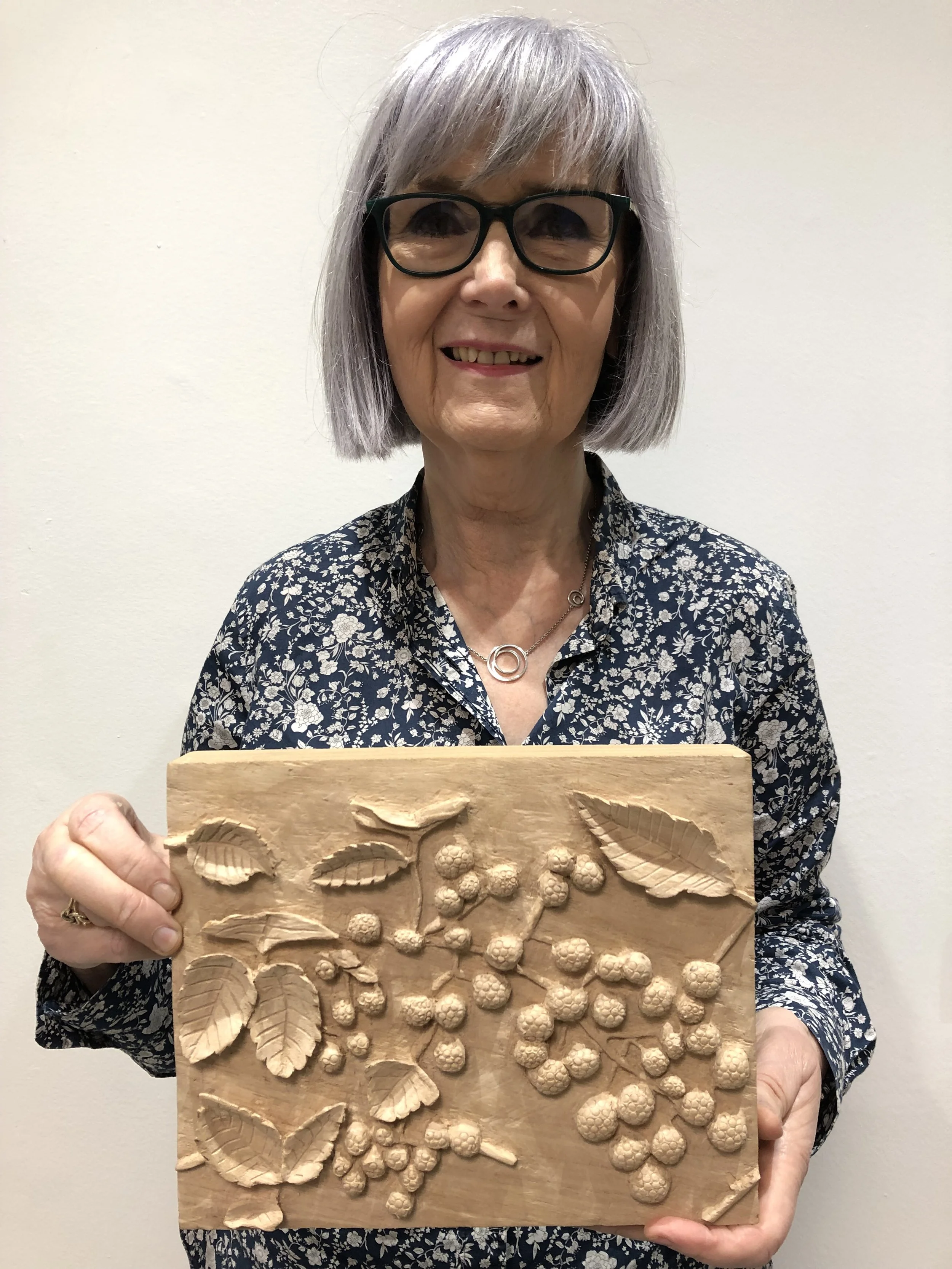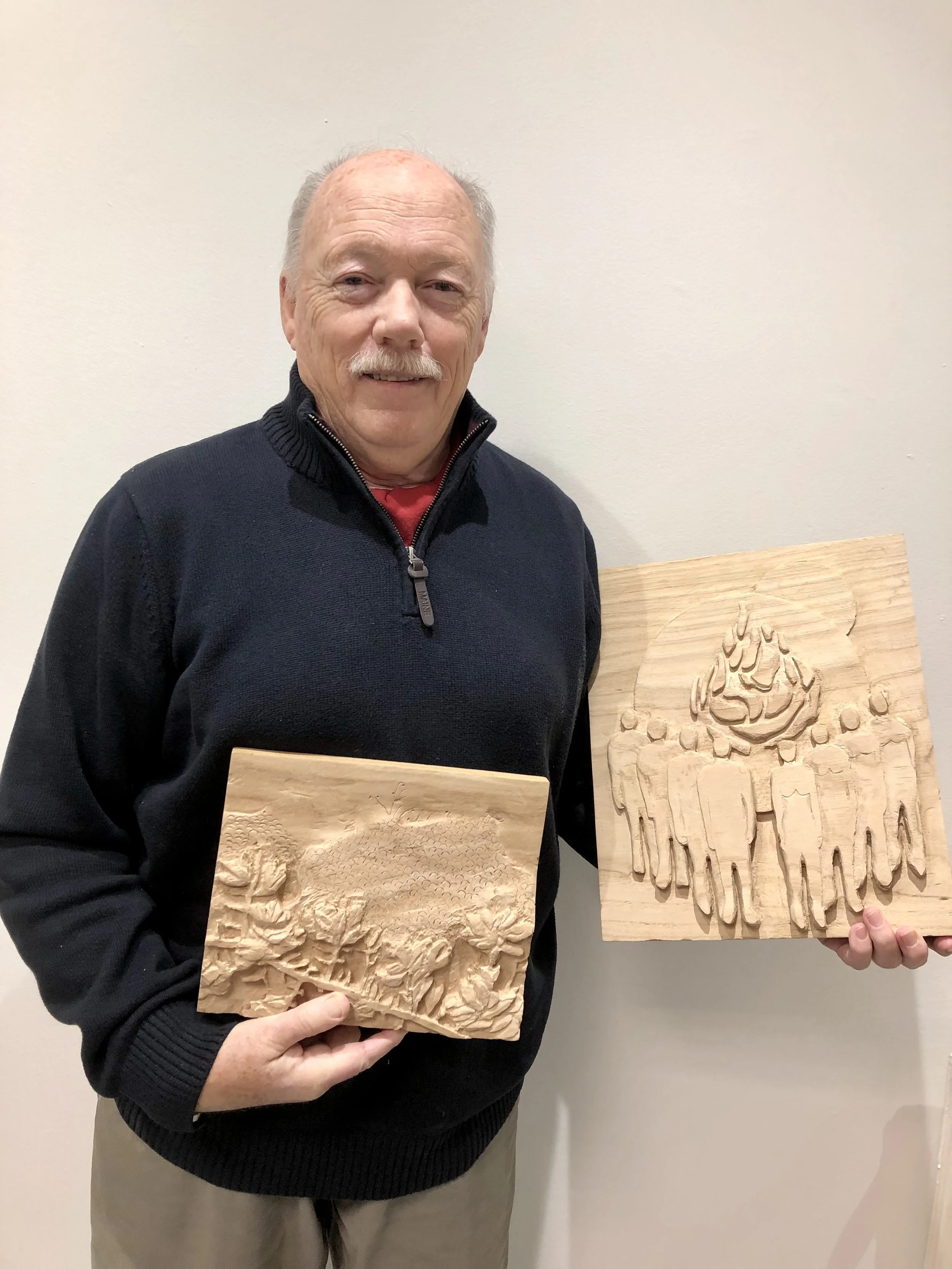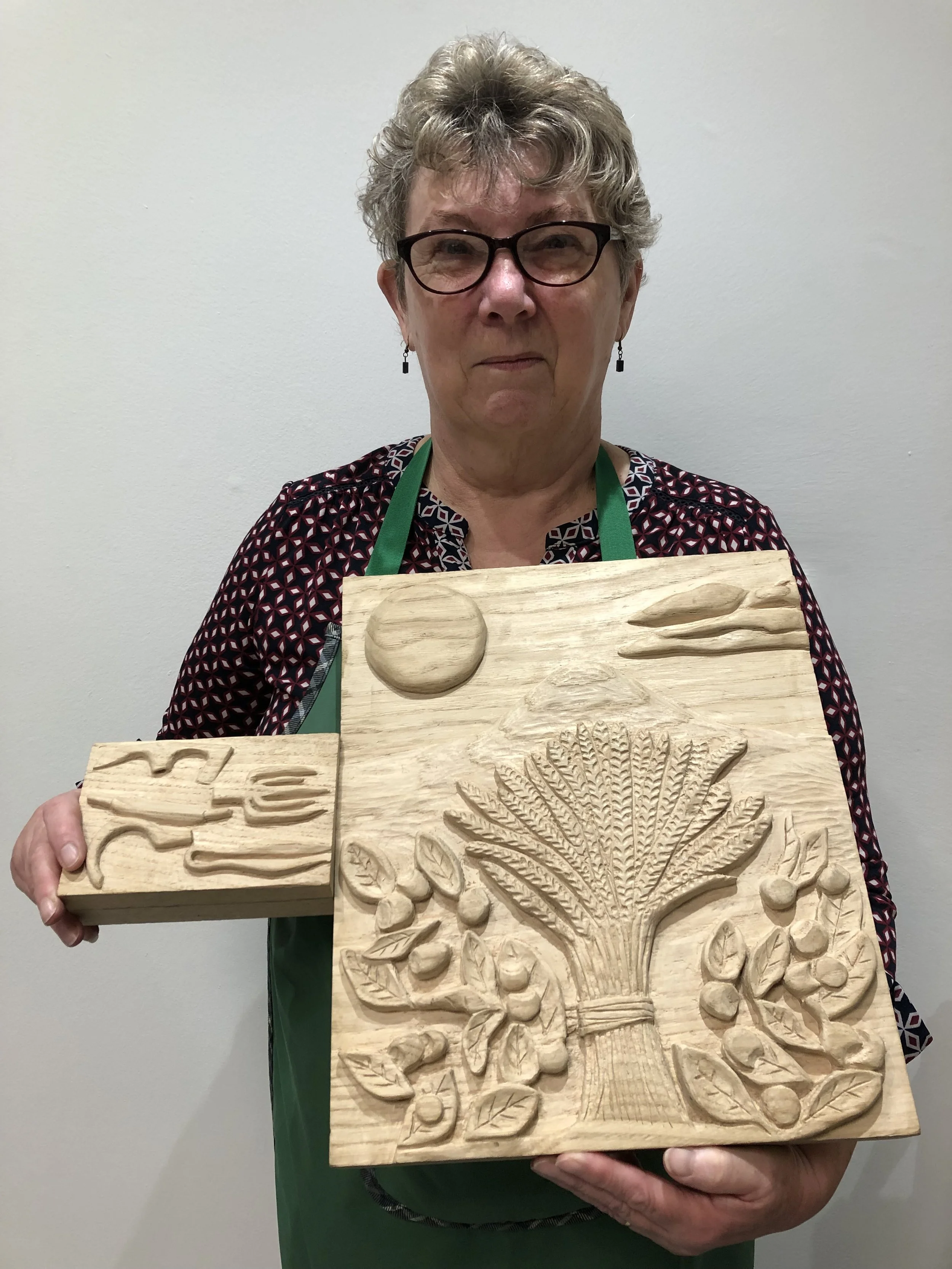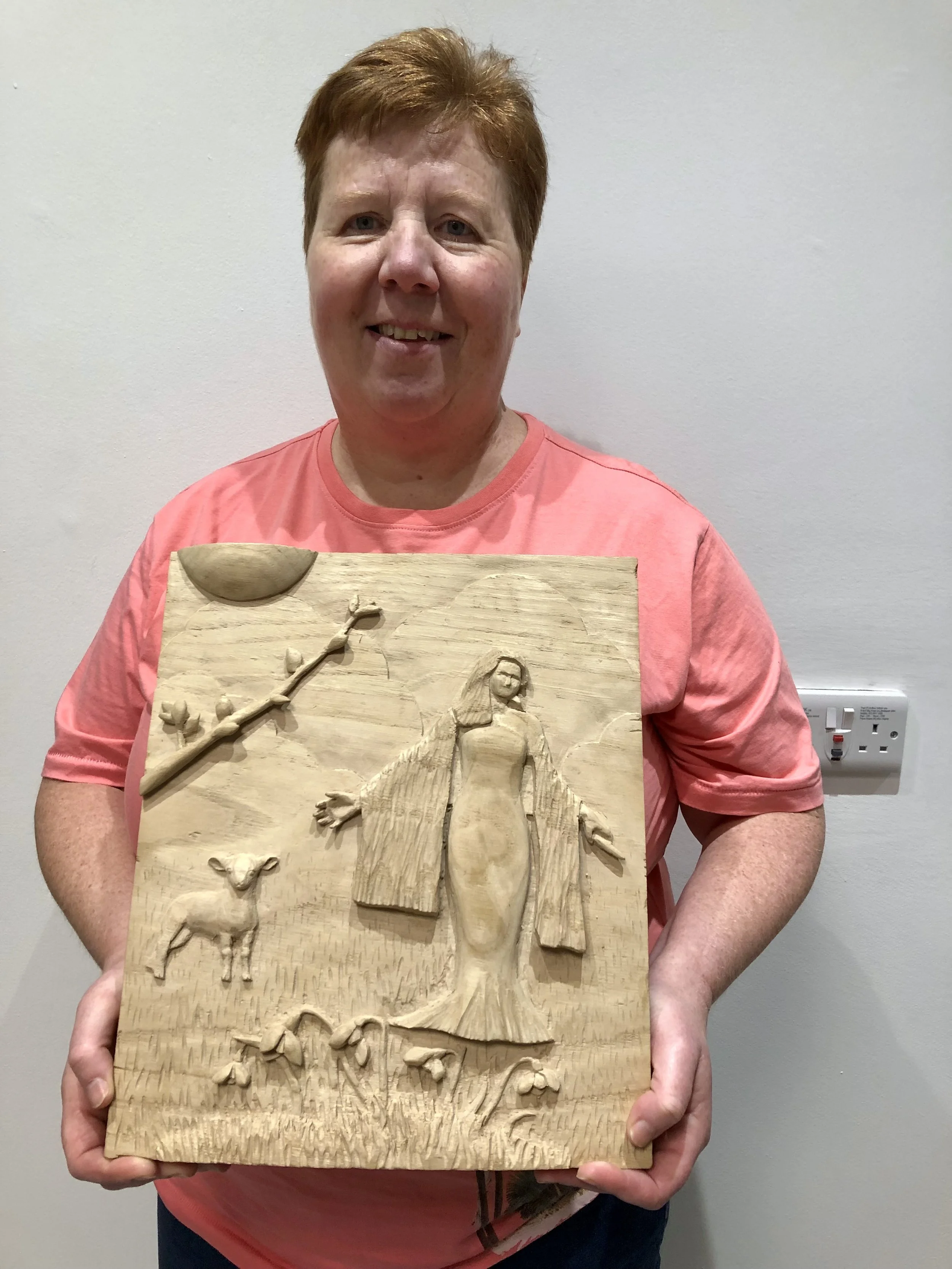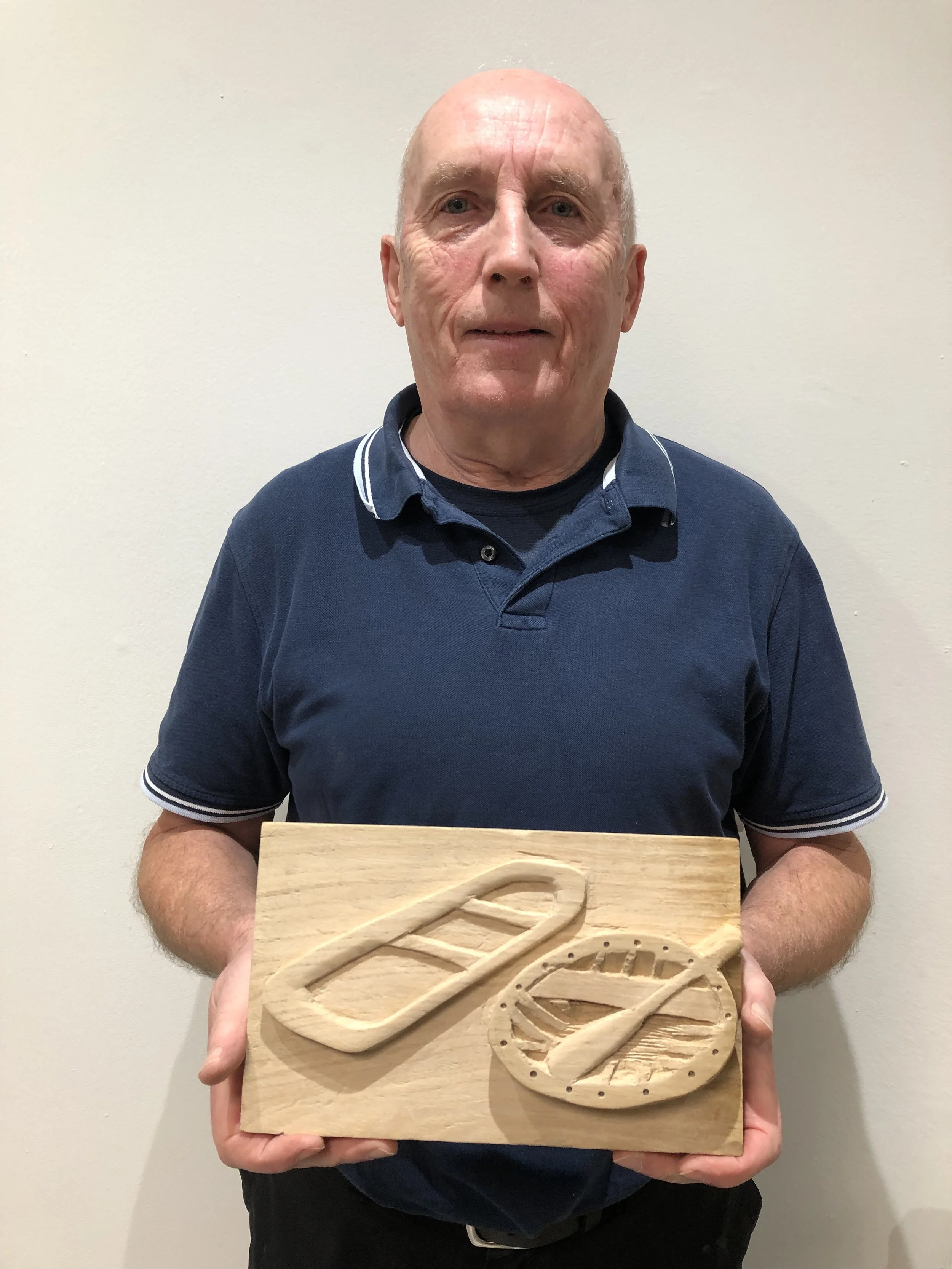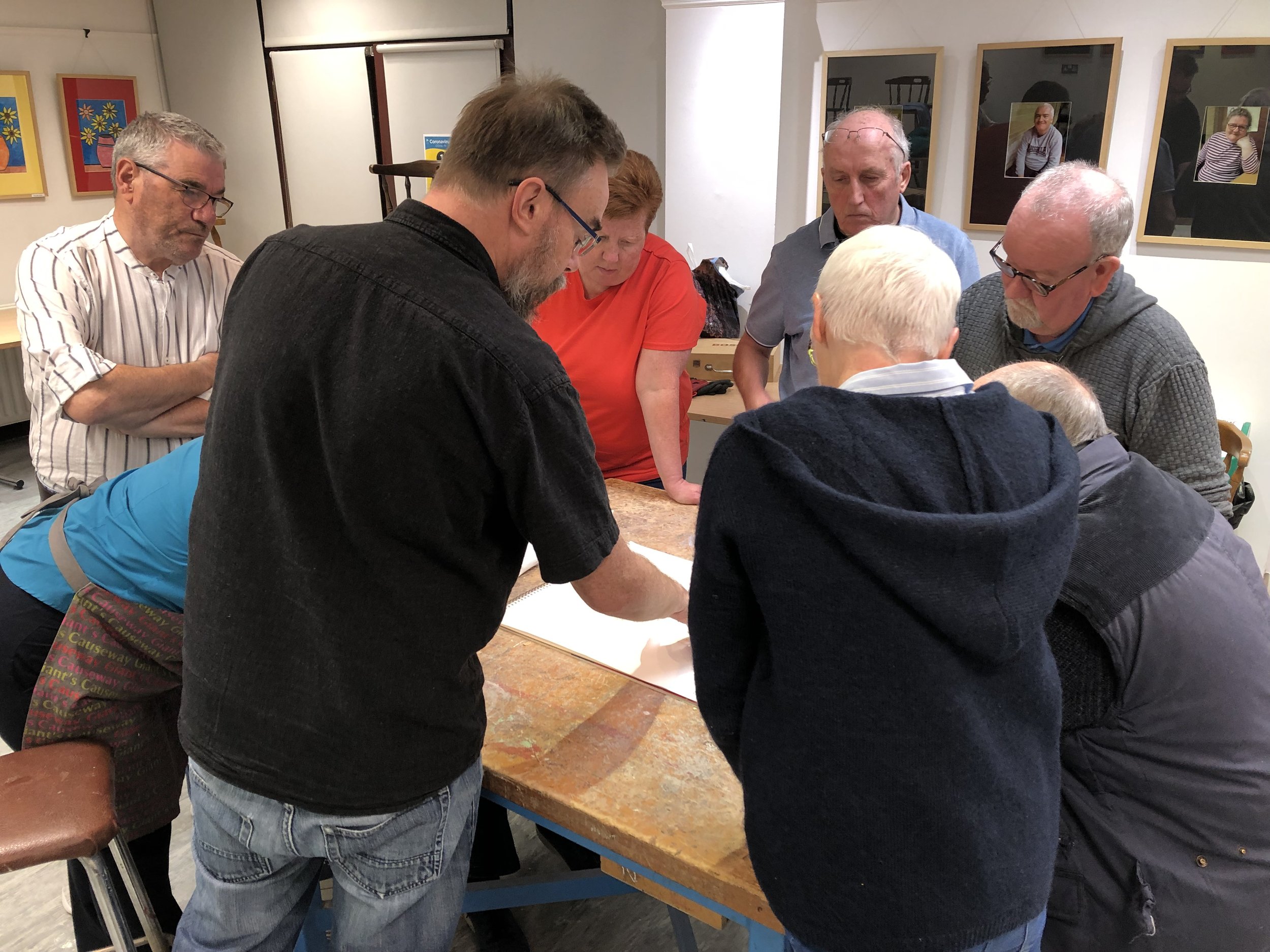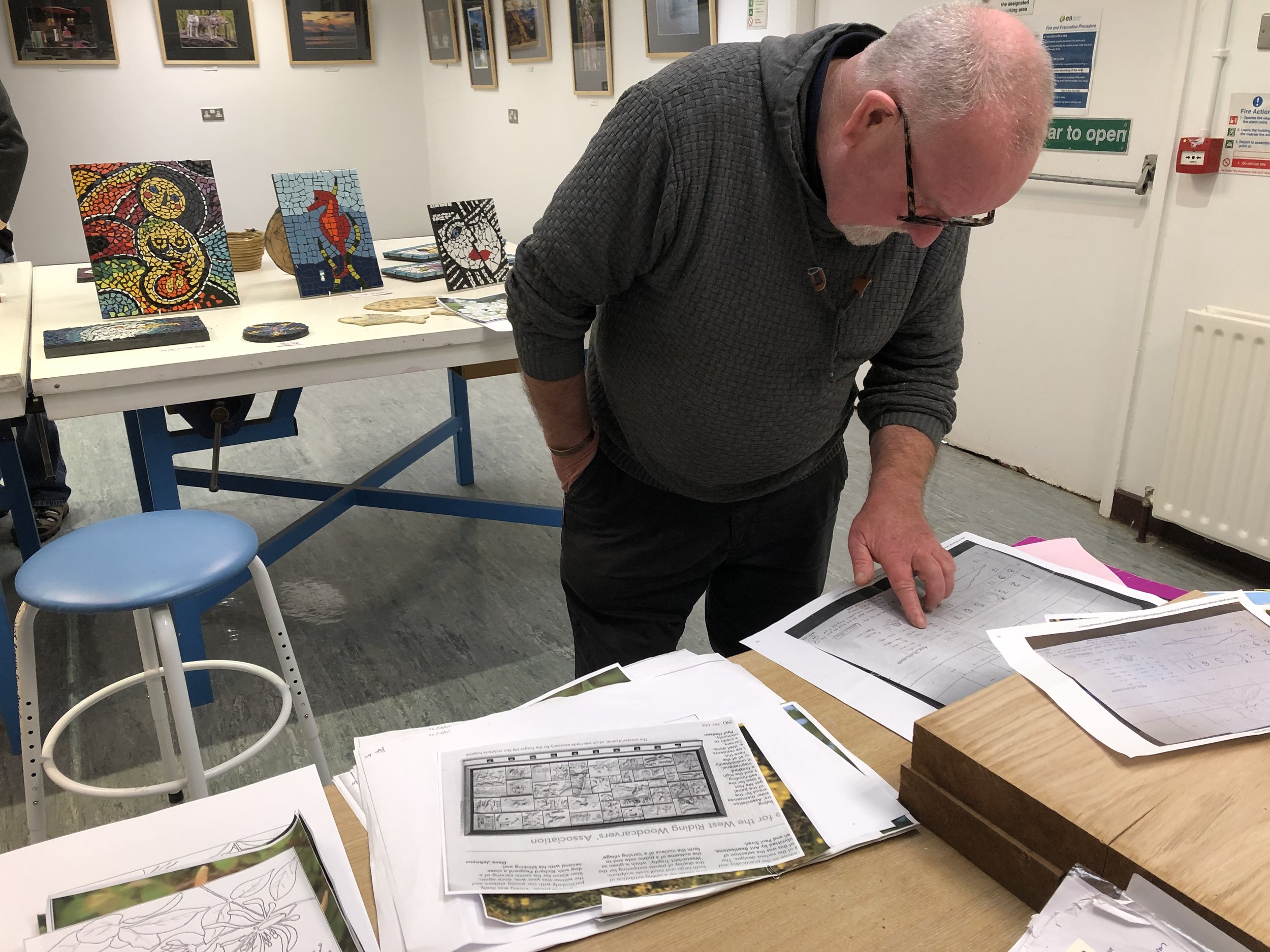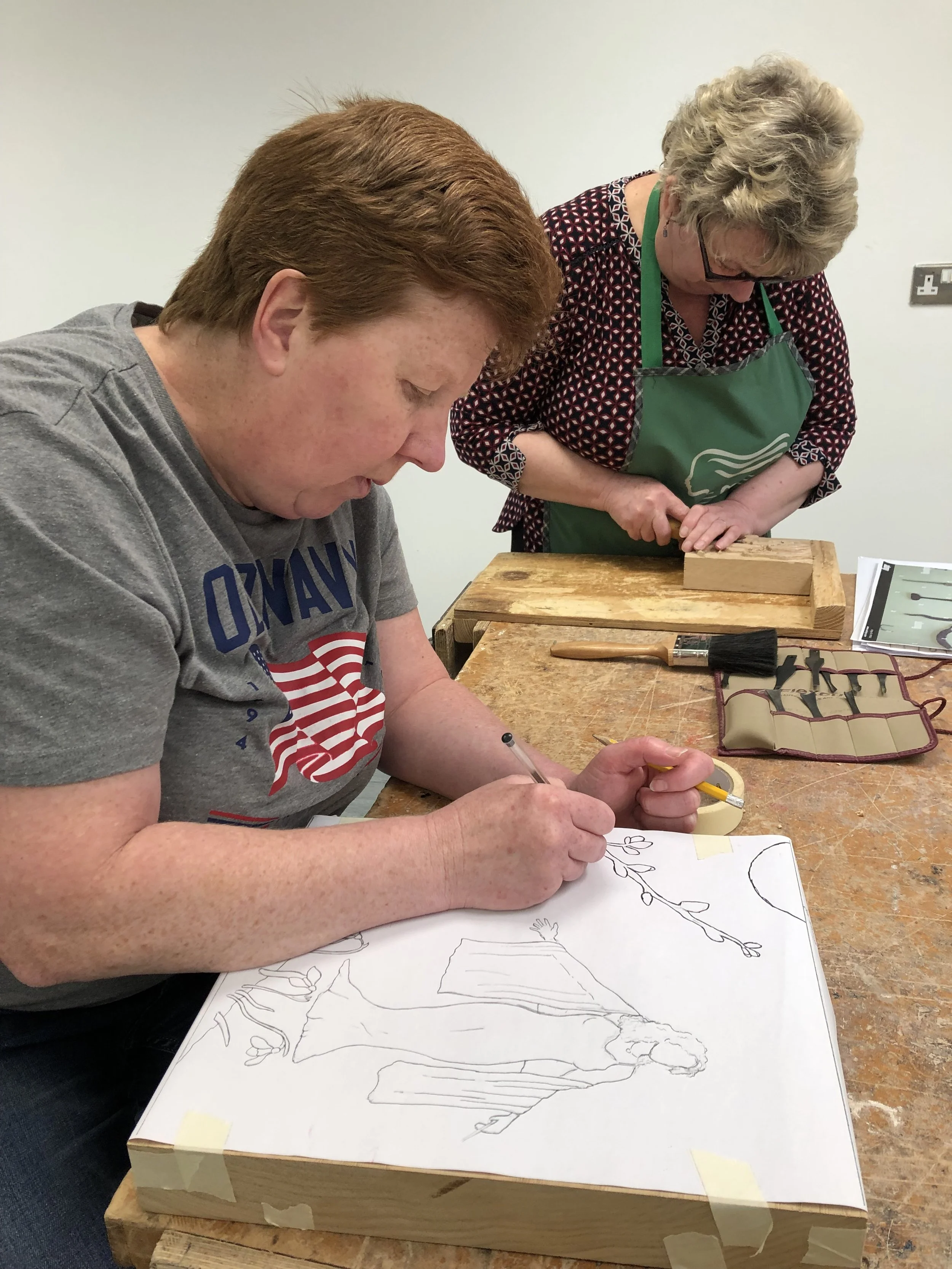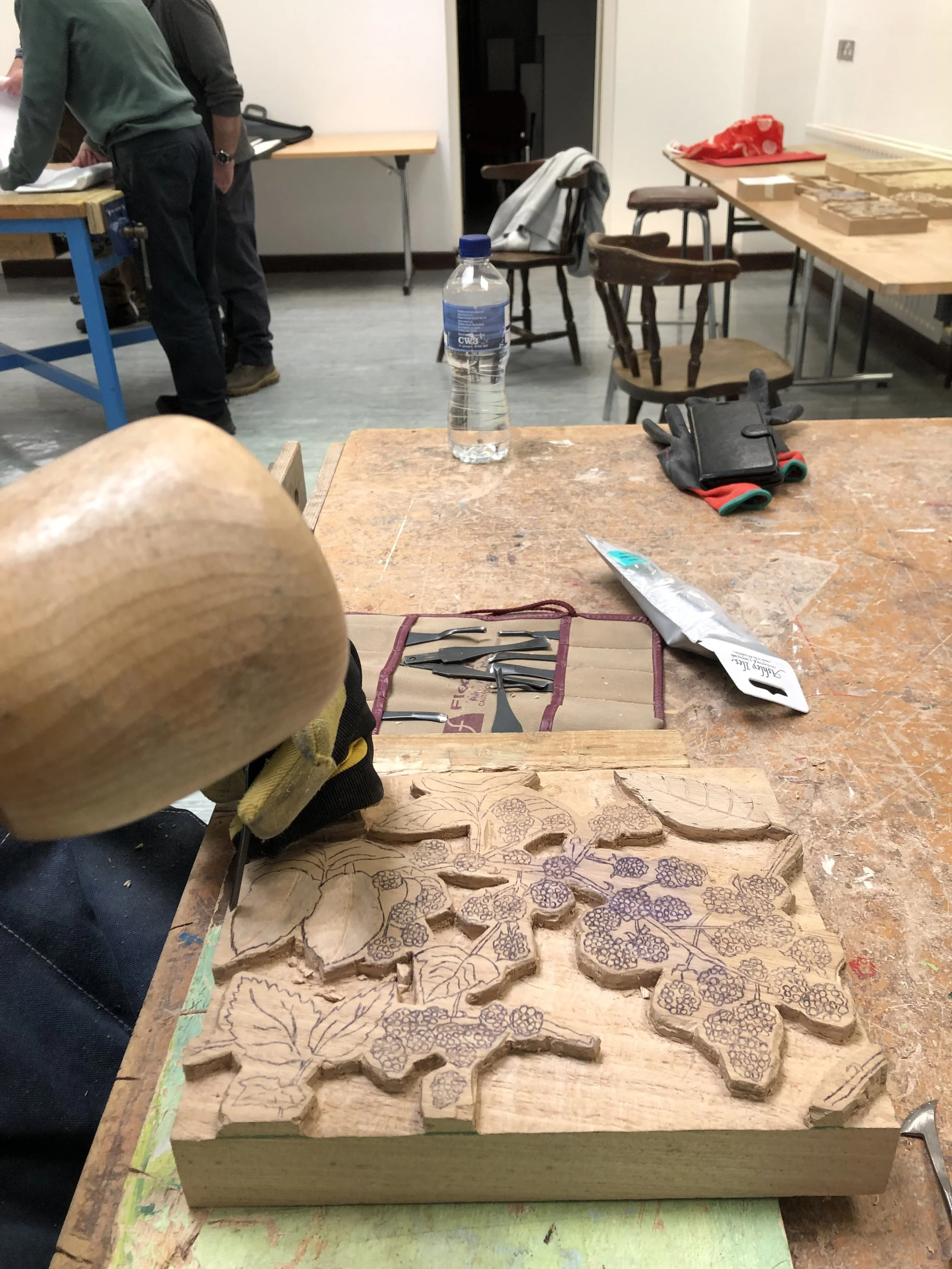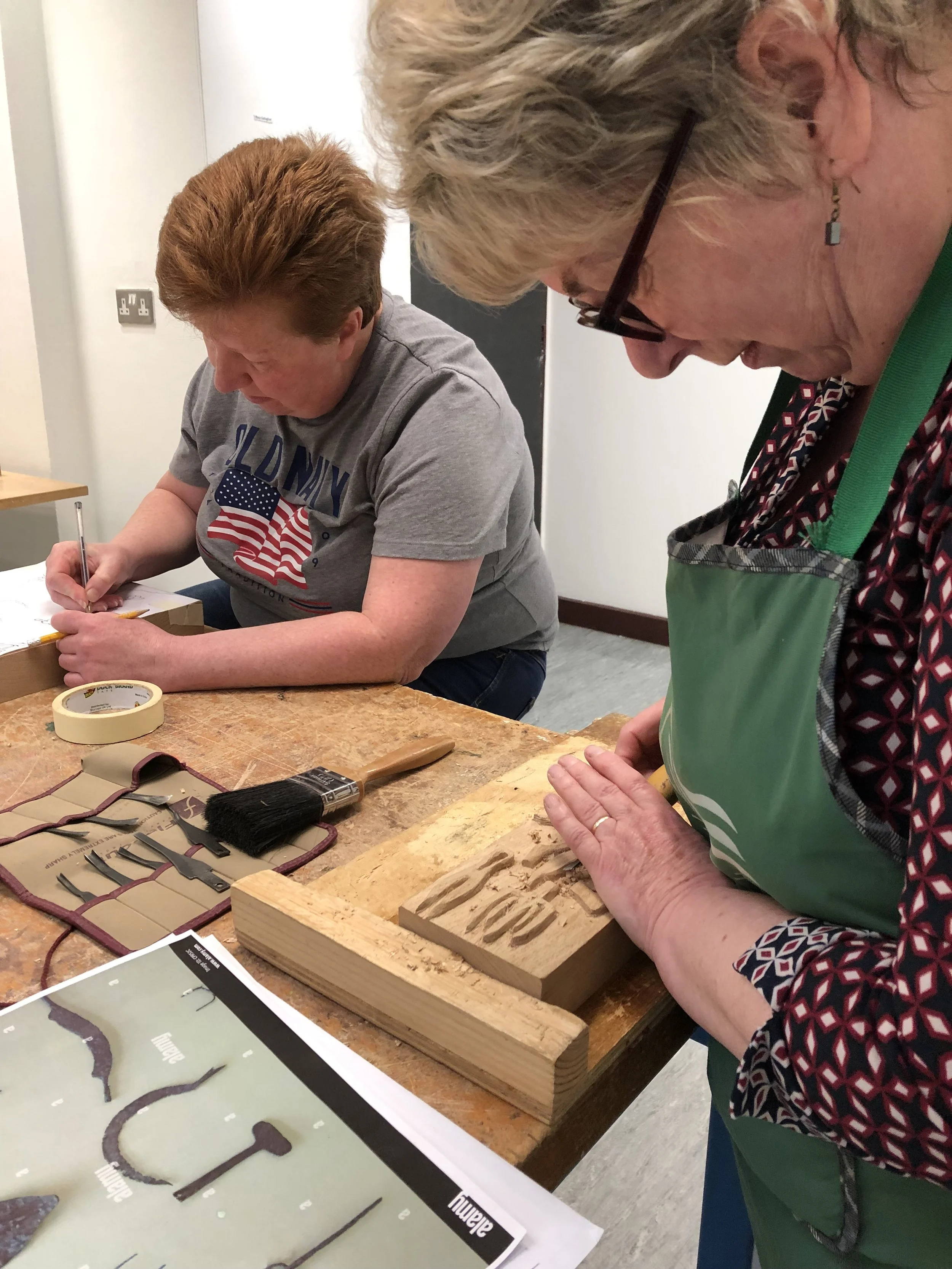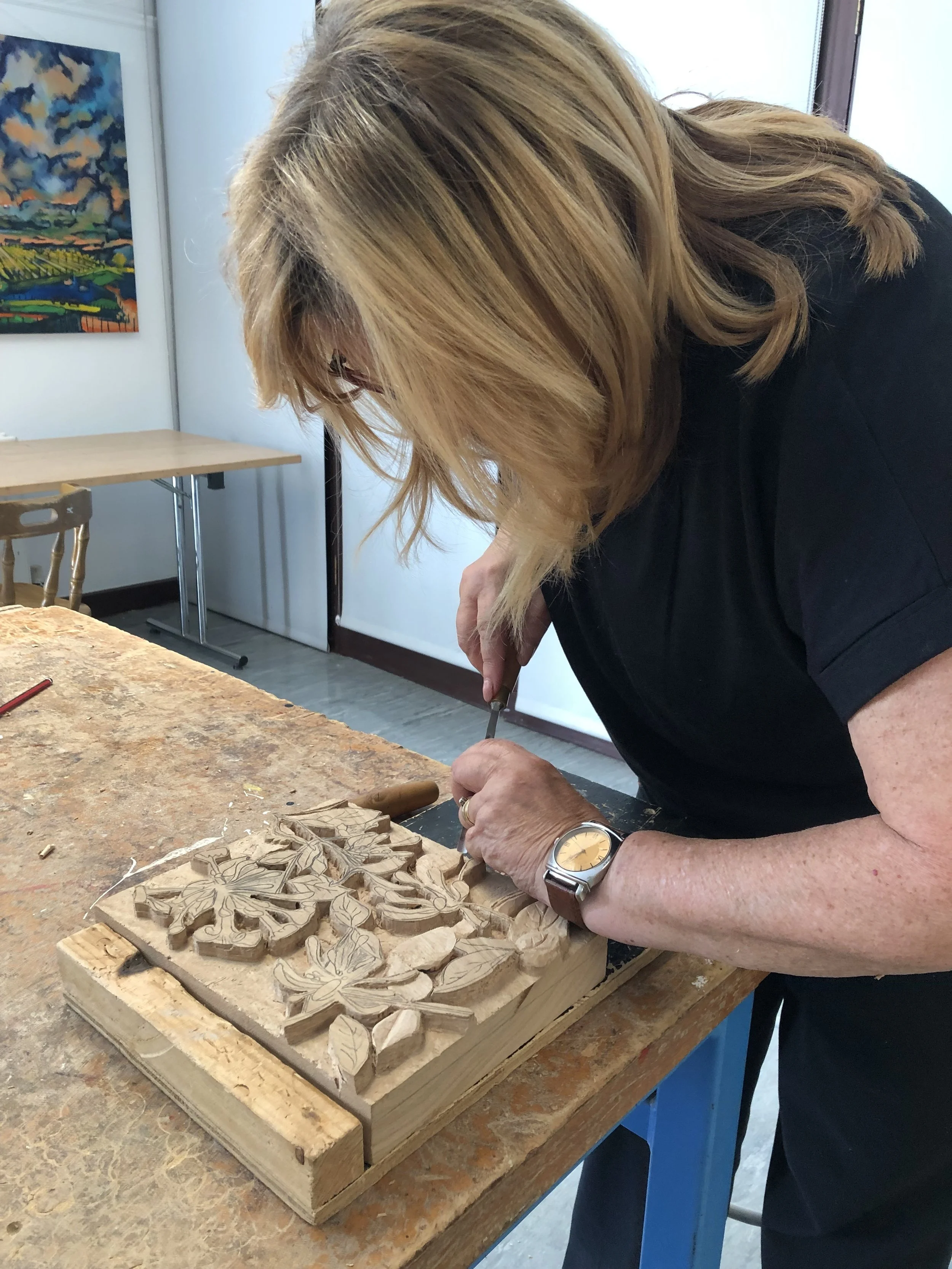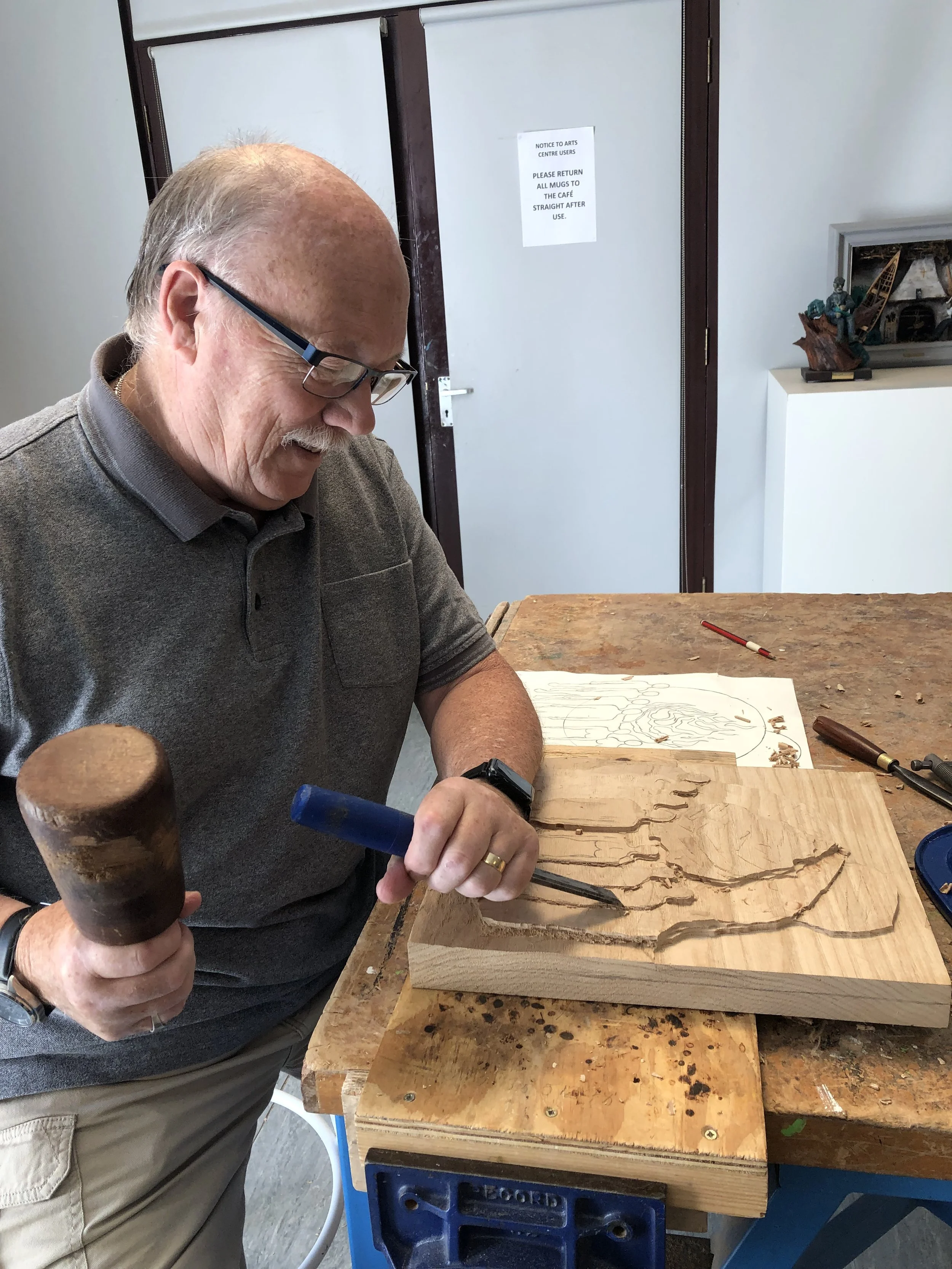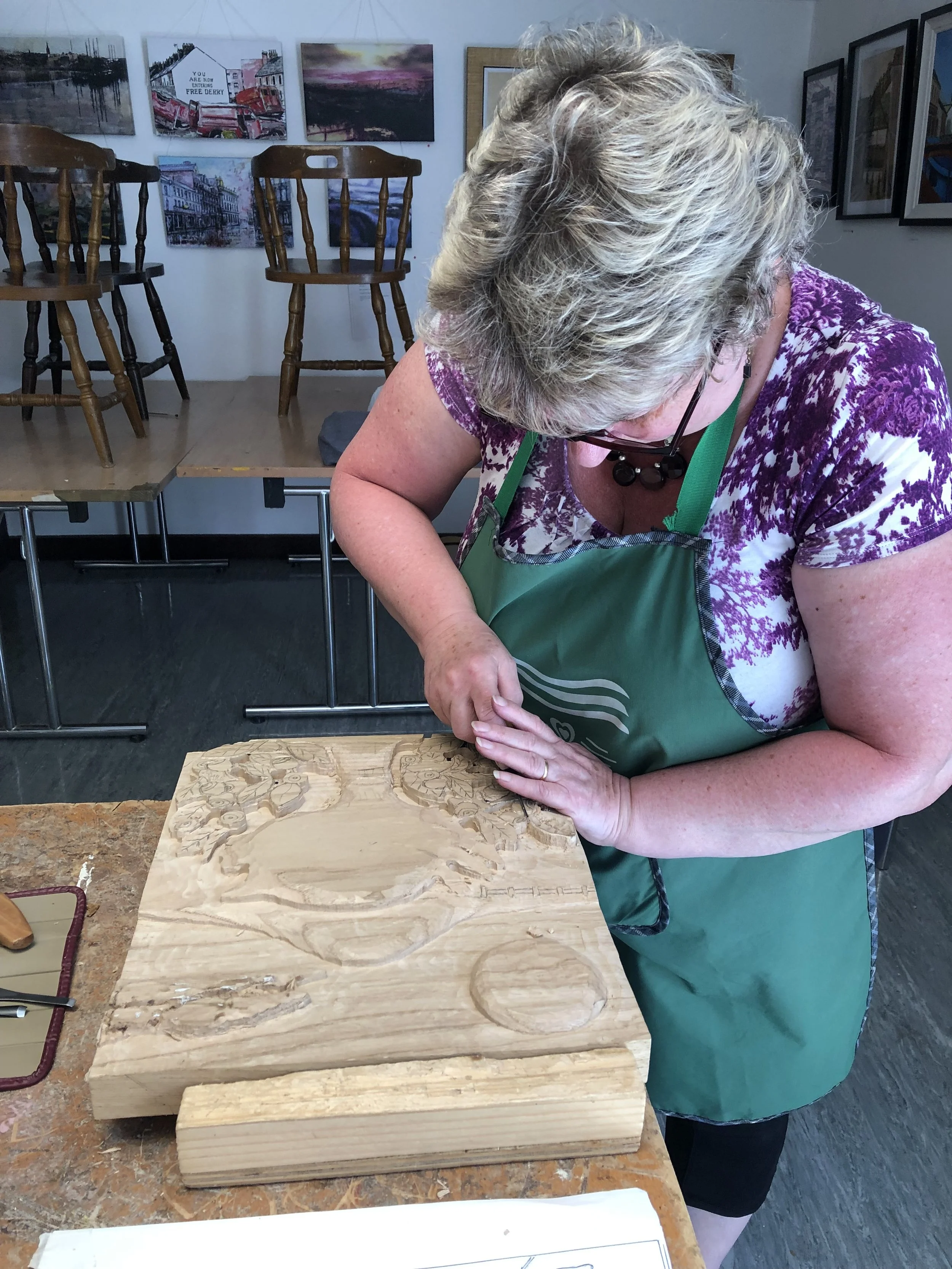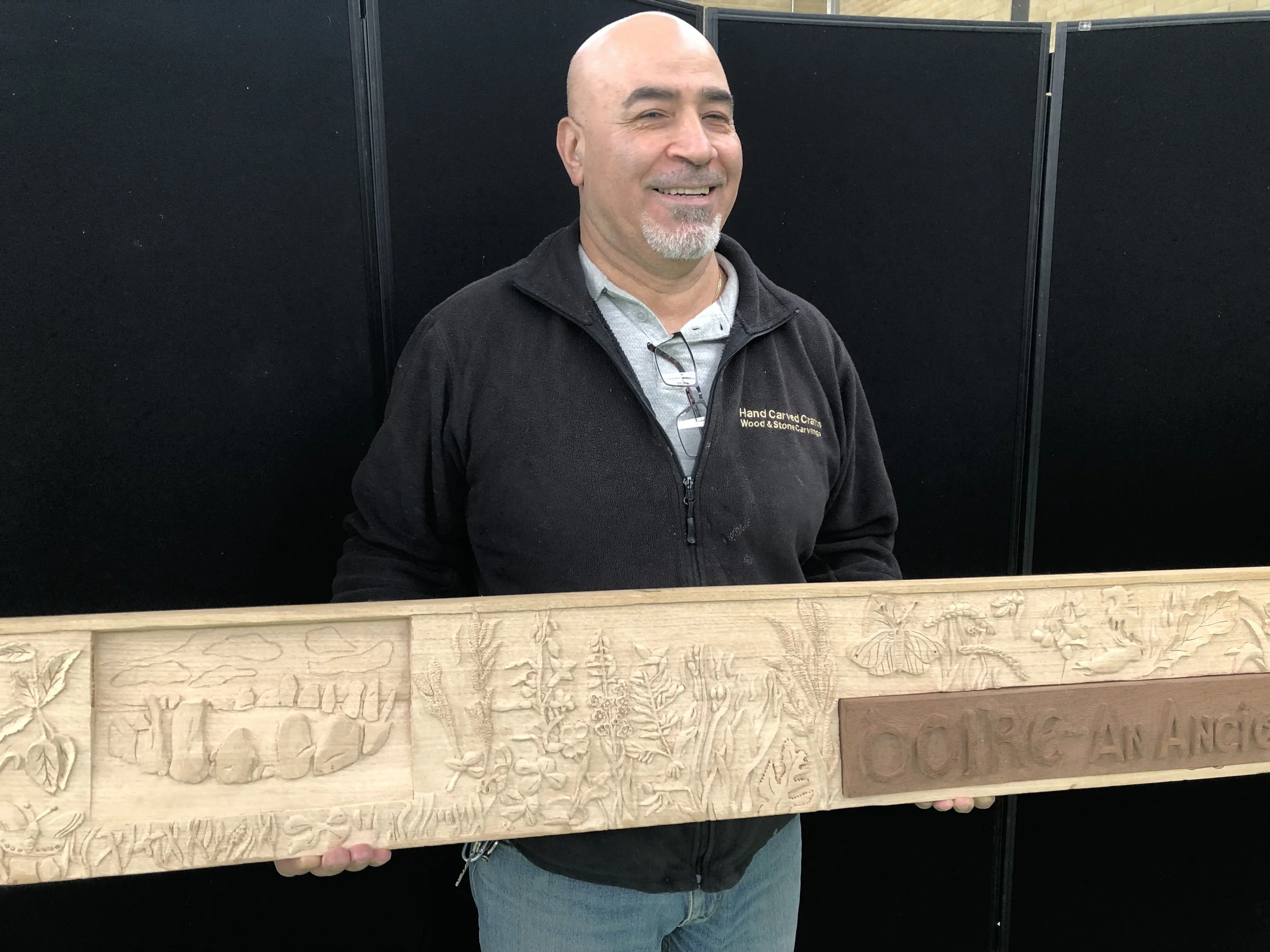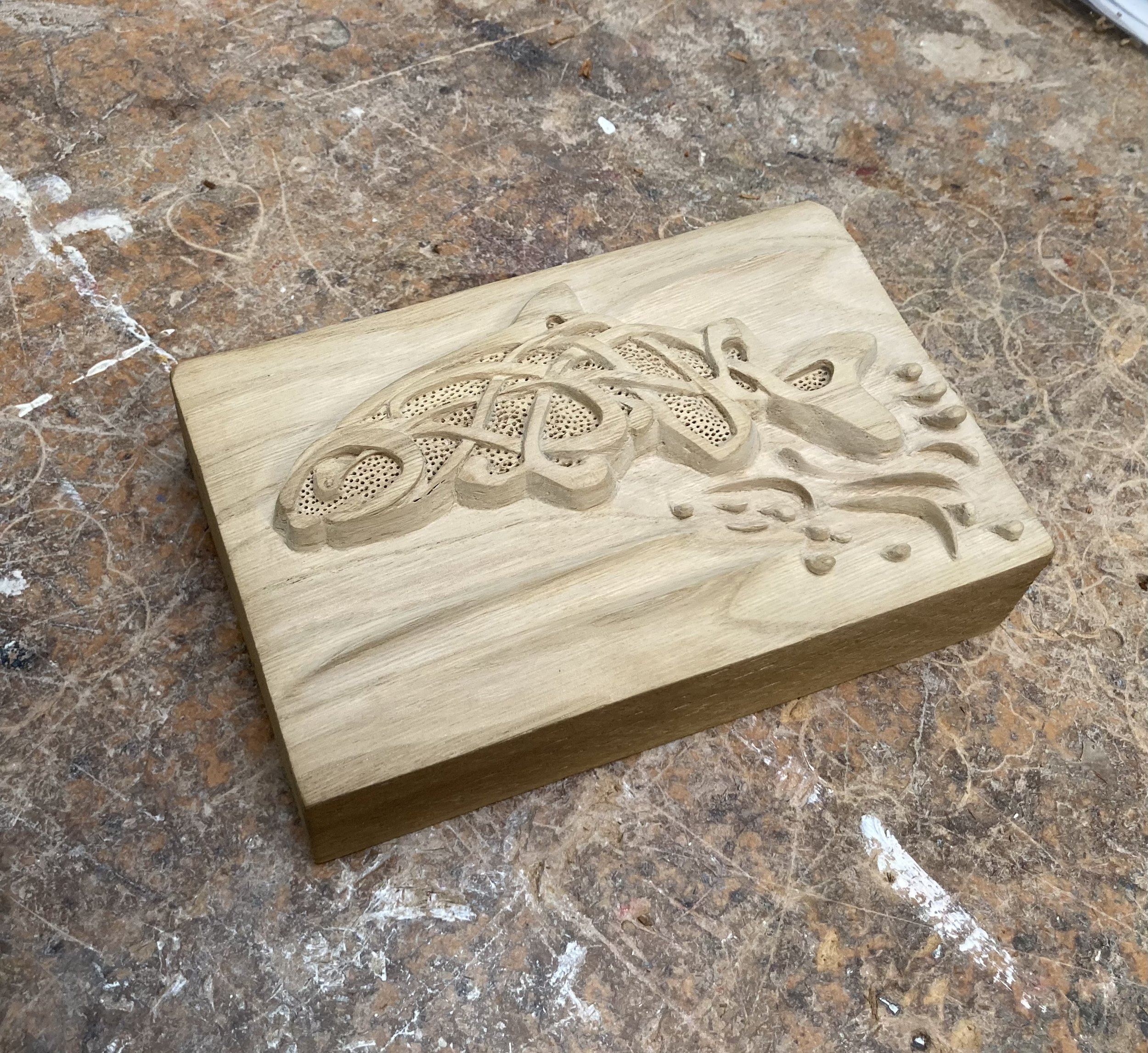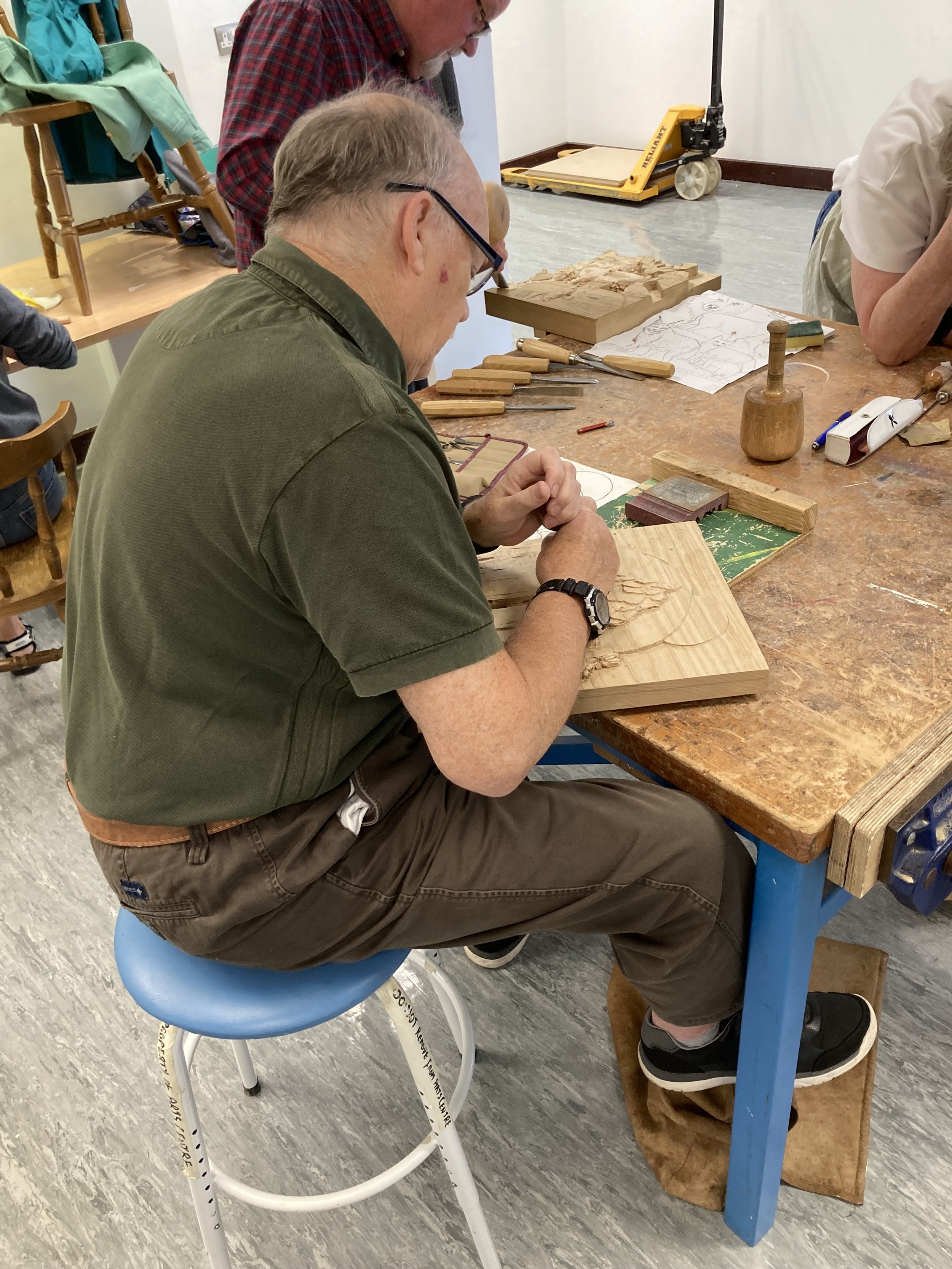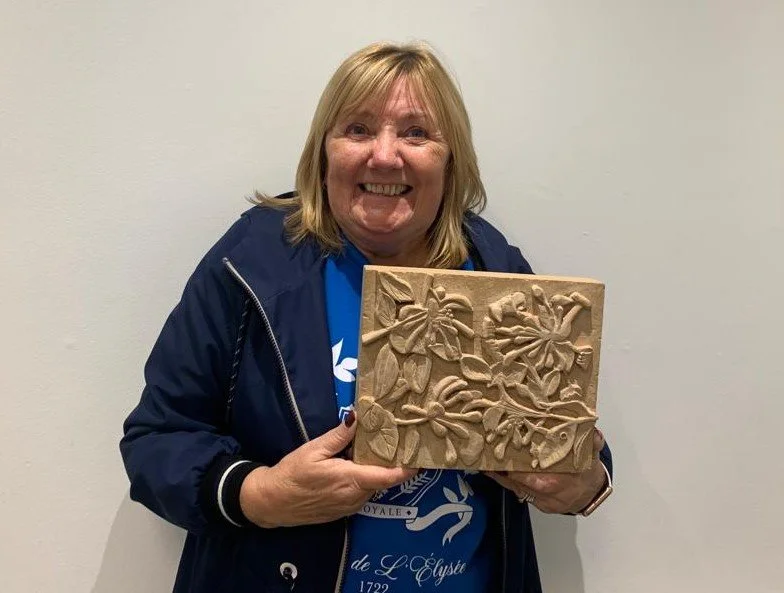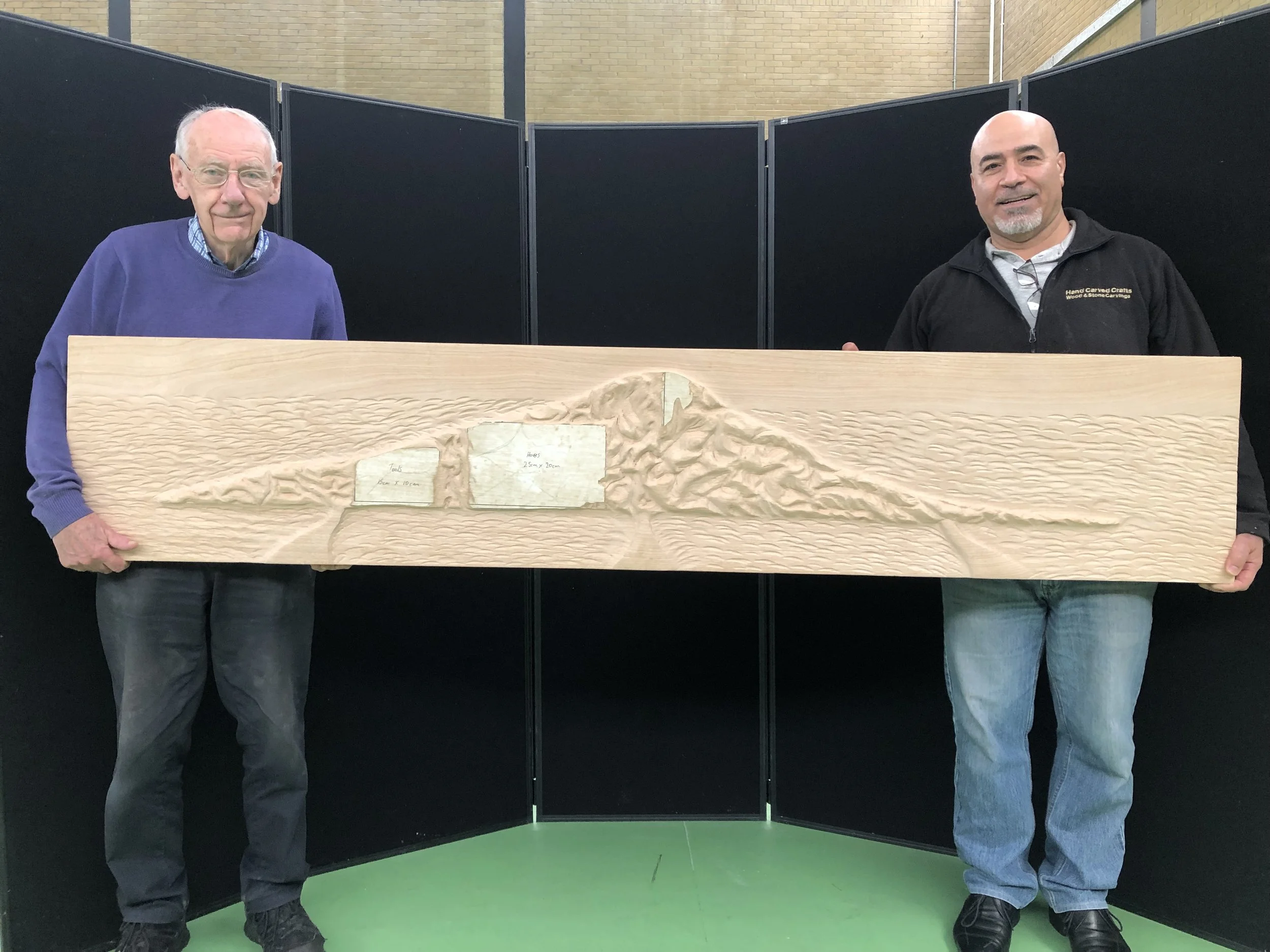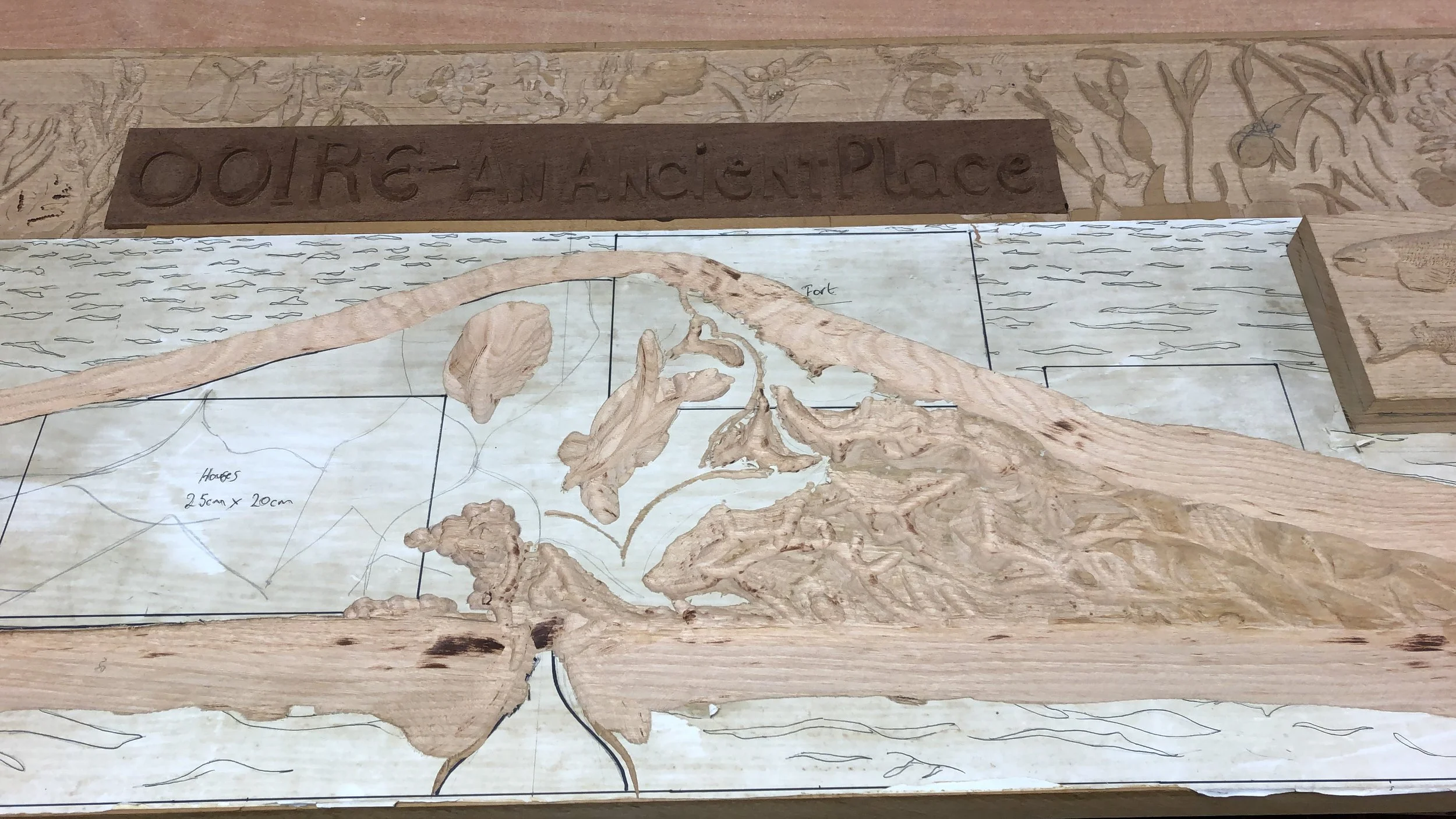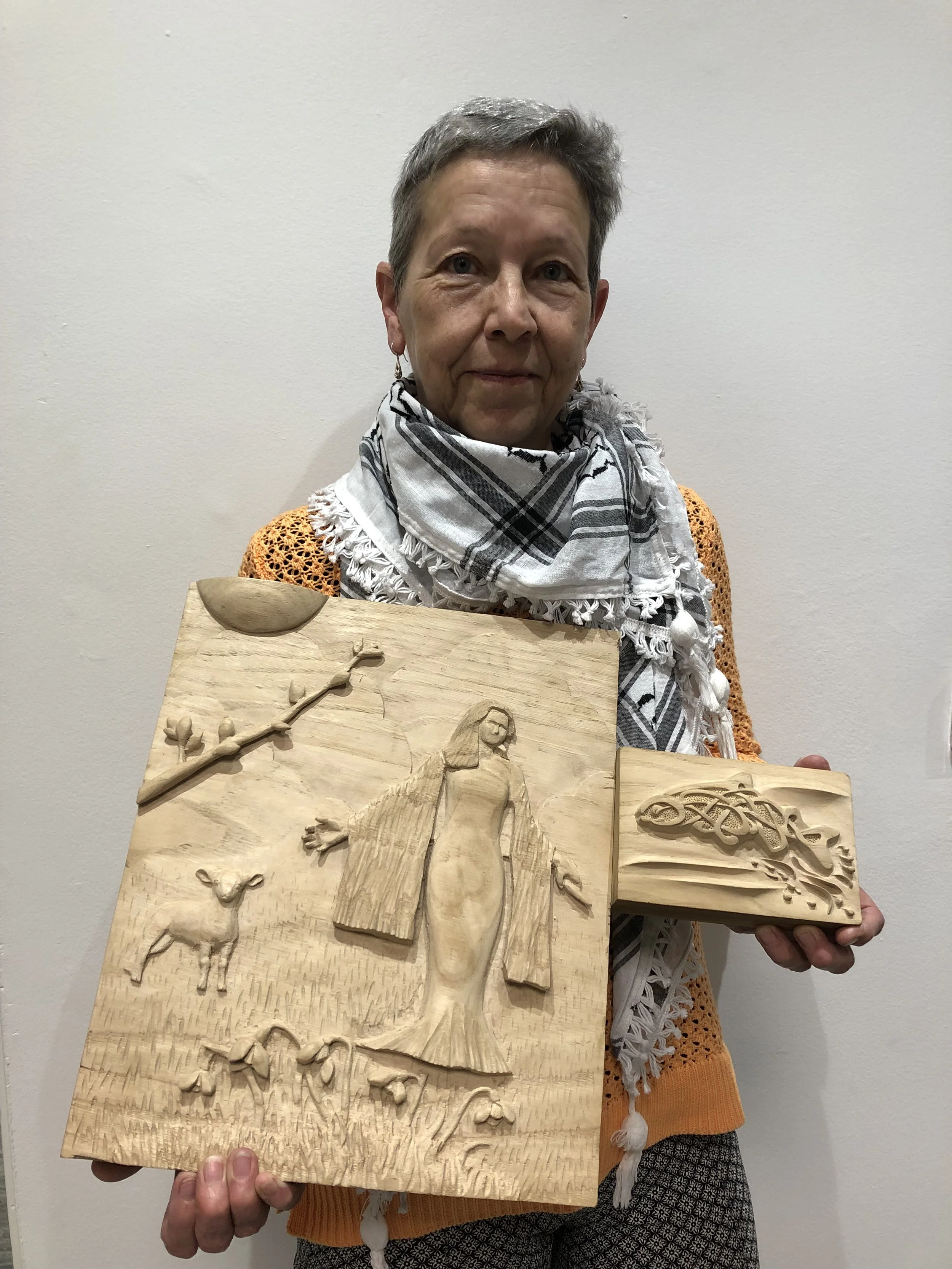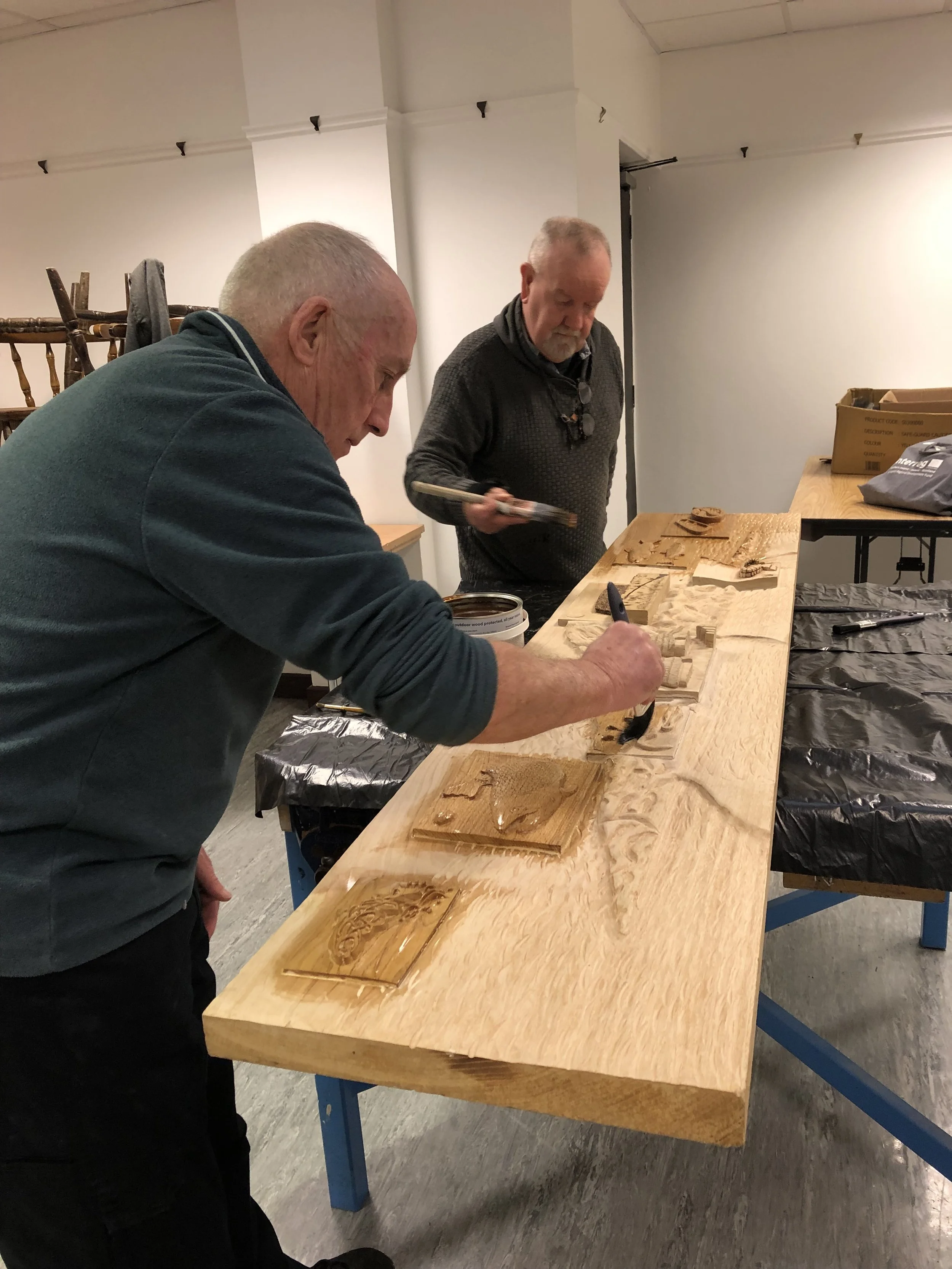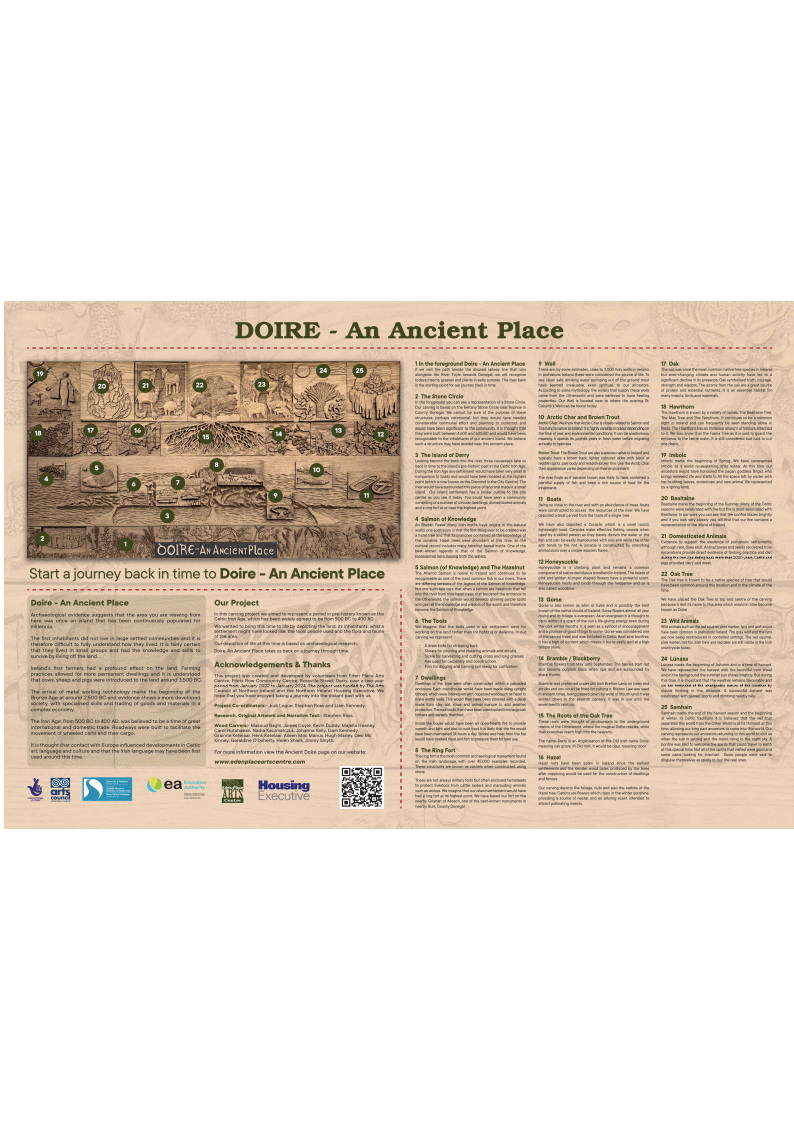
Doire - An Ancient Place
A Journey Into The Distant Past
Doire: An Ancient Place (Wood Carving Project)
Our carvings depict a journey into the distant past of our place.
Introduction
There is archaeological evidence to suggest that the place on which you stand has remained continuously populated for thousands of years. This is much further back in time than the beginning of a written history which began around 400AD by literate early Christian monks.
A long time ago
Looking back in time, at the peak of the last ice age around 24,000 years ago more than 3000 metres of ice covered the whole of Ireland extending beyond the southern coast. By 16,000 years ago the ice had re-treated so that only an ice bridge existed between Scotland and Ireland. By 14,000 years ago Ireland was isolated from the land mass of Britain and by 11,700 years ago the ice age was recognised as having ended. The earliest modern humans after the last ice age are thought to have been in Ireland since around 10,500 years ago.
These early people did not build large monuments or live in large settled communities and it is therefore difficult to gain an understanding of their lives and nature. It is fairly certain that they lived in small groups and had the knowledge and skills to take what they needed from the land to survive.
Ireland’s first farmers had a profound effect on the people and the land. Farming practices allowed for more permanent dwellings. It is understood that cows, sheep, and pigs were introduced to the changing land around 3,500 BC.
The arrival of metal working technology marks the beginning of the Bronze Age at around 2,500 BC and evidence of a more developed society with specialised skills and the trading of goods and materials in a complex economy.
The period of time known as the Iron Age, from 500 BC to 400 AD, was understood to be a time of great trade internationally as well as domestically and roadways were built to facilitate the movement of wheeled carts and their cargo.
It is thought that contact with Europe influenced developments in art, language and culture
such as the developments of Celtic art and even the Irish language which may have first been used around this time.
Our Project
Our project explores what attracted people to this place. We aimed to represent a period in pre-history as there would have been a complex society in place even then and so our project focuses on a period known as the Celtic iron age which has been widely agreed to be from 500 BC to 400 AD.
We wanted to bring to life this time by depicting the land, its inhabitants, what a settlement might have looked like, the tools people used and the animals that had been domesticated and what animals may be roaming in the wild nearby and the fish in the river.
Our depiction of life at this time is based on archaeological research, recreations, study of plants and animals, Navan Fort, An Granian Ring Fort, Beltany Stone Circle, Wild Ireland and the many traditions which have survived and evolved over time.
We hope this project inspires you to find out more about a time long ago and perhaps gain a new appreciation for the special place where you are.
And so, to begin …
An Ancient Place beckons.
In the foreground
Today, the city is the fifth most populated on the island of Ireland, it encompasses many districts on both sides of the river Foyle is an area of around 150 square miles. If we visit the River Bank on the path along the old railway line that runs alongside the river towards Donegal we see insects, grasses and plants
Looking beyond the river bank we see three causeways linking us to the ancient past.
During the Iron Age any settlement would have been very small in comparison to today and would have been in the location we now consider to be the city centre with the Diamond area being the highest point and stretching down to the river which would have surrounded this piece of land and made it a small island. Our island settlement has a similar outline to the city centre as it is today. You could have seen a community consisting of a number of circular dwellings, domesticated animals and a ring fort at or near the highest point on the island. You may also have noticed, by the water’s edge, some forms of small boat for fishing and for travelling to the mainland possibly to hunt or forage.
What kind of plants would have been growing at that time?
As the ice retreated the seeds of trees such as hazel and oak were brought here to Ireland by birds and animals across land bridges connected to Britain and the rest of Europe. The seeds of other trees are so light that they were blown by the wind.
When the ice completely melted the seas rose and the ice bridges connecting the land masses disappeared Ireland became an island and what we consider native species had arrived here. There are 28 native Irish tree species. The plants and shrubs we have represented are likely to be familiar if you have visited woodlands in Ireland and we hope this familiarity helps bring the past to life for you.
Oak
The Oak tree is known to be a native species of tree that would have been common around this location and in the climate of the time.
In our work the oak tree takes a prominent position and can be found represented in a number of areas around our sculpture. We have placed the Oak Tree at top and centre of the carving because it lent its name to this area which would in time become known as Doire.
Oak Tree carved by Jimmy Smith
The Roots of the Oak Tree
The roots were thought of as doorways (the name Derry is an anglicisation of the Old Irish name Doire, meaning oak grove, which means ‘oak’ – in Old Irish, it would be daur, meaning ‘door’) to the underground realms of the otherworld, where the magical Sidhe resided, while their branches reached high into the heavens
You will see the complex roots of the oak tree and this represents our strong link to the area but it also represents a link to our ancestors who may have been among the resilient and resourceful people that inhabited this place over thousands of years.
Hazel
Hazel nuts have been eaten in Ireland since the earliest settlements and the slender wood poles produced by the trees after coppicing would be used for the construction of dwellings and fences.
Our carving depicts the foliage, nuts and also the catkins of the Hazel tree. Catkins are flowers which ripen in the winter sunshine providing a source of nectar and an alluring scent intended to attract pollinating insects. However, early in the near at the beginning of spring there are not many insects around and so the hazel uses the wind to distribute its pollen from the male catkin to a tiny female flower for pollination.
Each catkin can consist of 240 flowers hanging from a single stem. When ripe it is very delicate and can easily disperse its pollen at the slightest movement. Successful pollination of the flower will result in the production of a hazel nut.
Bramble / Blackberry
Bramble flowers from May until September and the fruit starts red and becomes purple black when ripe and surrounded by sharp thorns.
Bramble was protected under old Irish Brehon Laws on trees and shrubs and you could be fined for cutting it. Brehon Law was used in ancient times when it was passed down by word of mouth until it was written down in the seventh century and was in use until the seventeenth century showing the importance of this shrub through time. Brehon law is the oldest surviving law system in Europe.
Blackberries are not to be eaten after Samhain because the Puca is said to spit on them making them inedible (the Puca is said to be a shape shifting troublemaker rumoured to be able take the shape of horses, wolves and hares and when in human form they will still have animalistic characteristics) There is some value behind this legend as wetter and cooler weather often allows the fruit to become infected by various moulds such as Botryotinia which give the fruit an unpleasant look and may be toxic.
Gorse
Gorse is also known as whin or furze and is possibly the best known and most widely distributed of the native shrubs of Ireland. Gorse flowers almost all year round and its foliage is evergreen. As an evergreen it is thought to carry within it a spark of the sun’s life-giving energy even within the dark winter months. It is seen then as a symbol of encouragement and a promise of good things to come.
Gorse was considered one of the sacred trees and was included in Celtic Beltane bonfires. It has a high oil content which means it burns easily and at a high temperature. The stock would be herded between these for purification and protection before being released onto the summer grazing.
The prickly nature of gorse gave it a protective reputation around livestock and provides an effective hedgerow.
Honeysuckle
Honeysuckle is a climbing plant and remains a common component of native deciduous woodland in Ireland. The heads of pink and golden trumpet shaped flowers have a powerful scent. Honeysuckle twists and binds through the hedgerow and so is also called woodbine.
Honeysuckle is pollinated by bees by day and by moths at night attracted by its wonderful scent. It develops bright red berries which are highly toxic.
The leaves and flowers of the honeysuckle are rich in salicylic acid and so may be used to relieve headaches, colds, flu, fever, aches pains, arthritis and rheumatism. Honeysuckle berries however are highly toxic.
Hawthorn
The Hawthorn is known by a variety of names, The Beltaine Tree, The May Tree and The Whitethorn for example. It continues to be a common sight in Ireland and can frequently be seen standing alone in a field. The Hawthorn has an immense amount of folklore attached to it. We also know it as the Faerie Tree as it is said to guard the entrance to the faerie realm and it is still considered bad luck to harm one. The Hawthorne has long been associated with fertility and Beltaine and washing in its dew is said to bring beauty and skill.
The young leaves and flower buds can be eaten or used as a medicine. Hawthorn is rich in bioflavonoids which have powerful medicinal properties which can help relax muscles and reduce risk of heart disease and can improve heartbeat rate and strength. It also contains proanthocyanins which are antioxidants which help repair tissue damage. It is traditionally thought to help mend broken hearts.
The Seasons
People who lived in the Celtic iron age would have been dependent on the land and what it could provide in terms of food and shelter and it is important that people would have developed a close connection with the land and climate. They would have needed to know how to work in partnership with the weather and the land and to understand when to plant, when to harvest and when to shelter. It appears that the seasons were familiar to those who lived here at this time and the names they gave to their seasons are now more becoming familiar again to us. Imbolc, Beltane, Lughnasadh and Samhain.
Imbolc
We have represented Imbolc as a world re-awakening after winter. It is represented in our work by Brigid bringing renewed life and beginning to fill the space left by winter. Brigid brings with her budding leaves, snowdrops and new animal life represented by a spring lamb.
Beltane
Many of the Celtic seasons were celebrated with fire but fire is most associated with Beltane. In our work you can see that the bonfire blazes brightly and if you look very closely you will find that our fire contains a representation of the island of Ireland.
Lughnasadh
Lughnasadh is a time to harvest. We have represented the harvest with the bountiful corn sheaf and in the background the summer sun shines brightly. But during this time, it is important that the weather remains favourable and we are reminded of the changeable nature of the weather by clouds forming in the distance. A successful harvest was celebrated with games, sports and climbing nearby hills.
Samhain
Samhain marks the end of the harvest season and the beginning of winter. In Celtic traditions it is believed that the veil that separates this world from the Other World is at its thinnest and this would allow our long past ancestors to come into this world. Our carving represents our ancestors returning to this world to visit us when the sun is setting and the moon rising is in the night sky. A bonfire was said to welcome the spirits that could travel to earth at this special time. Not all of the spirits that visited were good and some came looking for mischief. And some people were said to disguise themselves as spirits to fool the real ones.
The Ring Fort
The ringfort is the most common archaeological monument found on the Irish landscape with over 45,000 examples recorded. These structures are known as cashels when constructed using stone.
These are not always military forts and were often enclosed farmsteads to protect livestock from cattle raiders and marauding animals such as wolves. We imagine that our island settlement would have had a ringfort at its highest point. We have based our fort on the nearby Grianan of Aileach one of the best-known monuments in nearby Inishowen.
The Boats
Being so close to the river and with an abundance of trees it is likely that boats were constructed to access of the resources of the river, the lands nearby and to make use of the natural defences associated with island living.
We have depicted a boat carved from the trunk of a single tree. A craft similar to this was re-created by University College Cork in 2019 and was based on a boat that was discovered on the bottom of Lough Corrib, Co Galway. It took around 18 days to carve from the felled tree.
We have also depicted a Coracle which is a small round and lightweight boat. A coracle makes an effective fishing vessel when used by a skilled person as they barely disturb the water or the fish and can be easily manoeuvred with one arm while the other arm tends to the net. Two coracles could be used and the net held between them. A coracle is constructed by stretching animal skins over a simple wooden frame.
The Tools
We imagine that the tools used in our settlement were for working on and with the land rather than for fighting or defence. In our carving we represent
A draw knife for stripping bark
Shears for pruning and shearing animals and shrubs
Sickle for harvesting and cutting crops and long grasses
Axe used for carpentry and construction
Fork for digging and turning soil ready for cultivating
The Fish
The river Foyle as it became known was likely to have contained a plentiful supply of fish and been a rich source of food for the inhabitants of our island.
Arctic Char: We know that Arctic Char which is closely related to the Salmon and Trout and is native to Ireland. It is highly variable in colour depending on the time of the year and environmental conditions. It can be anadromous, meaning it spends its juvenile years in fresh water before migrating annually to open sea.
Brown Trout: The Brown Trout are also a species native to Ireland and typically have a brown back, lighter coloured sides and with black or reddish spots, pale body and reddish-brown fins but like the Arctic Char they are variable in appearance depending on their localised environment. Brown Trout thrive in rivers with cool temperatures and high oxygen levels Some brown trout spend their entire life close to the stretch of river where they were born while others migrate from rivers to lakes or estuaries and back again to spawn.
Salmon: The Atlantic Salmon is also native to Ireland and continues to be recognisable as one of the most widespread fish in our rivers. The Salmon has a complex life cycle that includes a freshwater and seawater phase. Salmon hatch in freshwater and can stay in the river for two to three years before undergoing physiological change and migrating to feeding grounds thousands of miles away around the Norwegian Sea and coast of Greenland before using their incredible homing instinct to return to the river they were hatched after one or more winters at sea to reproduce.
The migration of these species of fish would mean that there could well have been more plentiful times when they could be caught as they passed our island in the river and became an important food source for its inhabitants.
Salmon of Knowledge
Many myths have origins in the natural world. As hazelnuts were often a more abundant source of protein than animals, the cultural record includes many myths of the hazelnut. One such story represented in our work is the tale of the Salmon of Knowledge. There are differing versions but in one such tale it is said that when a salmon ate hazelnuts that fell into the river from nine hazel trees that bordered the entrance to the Otherworld the salmon would gain glowing purple spots and gain all the knowledge and wisdom of the world to become the Salmon of Knowledge. We have placed the hazel above the river where the nuts can fall and be eaten by a salmon which is then transformed into the Salmon of Knowledge.
Dwellings
Dwellings of the time were often constructed within a palisaded enclosure. Each roundhouse would have been made using upright timbers, which were interwoven with coppiced wood such as hazel to make wattle walls. This would then have been covered with a daub made from clay, soil, straw and animal manure to add weather protection. The roof could then have been constructed from large oak timbers and densely thatched.
Inside the house would have been an open-hearth fire to provide warmth and light and also to cook food. It is likely that the fire would have been maintained 24 hours a day. Smoke and heat from the fire would have smoked meat and fish to preserve them for later use.
Well
There are, by some estimates, close to 3,000 holy wells in Ireland. In prehistoric Ireland these were considered the source of life. To see clean safe drinking water springing out of the ground must have seemed invaluable, even spiritual, to our ancestors. According to some mythology, the waters that supply these wells came from the Otherworld.
With the coming of Christianity in the fifth century Christian missionaries prayed beside and blessed these wells making them even more sacred than they were before.
Some visitors to the sacred well would tie pieces of cloth as offerings for thanks or favour. These cloths were known as clooties and the wells became known as clootie wells. In our work, we have placed a well at a location that is similar to where the modern-day St Columb’s Well is located.
Animals – Domesticated
Evidence to support the existence of prehistoric settlements, although rare, does exist. Animal bones and seeds recovered from road and gas pipeline excavations provide direct evidence of farming practice and diet during the iron age dating back more than 2000 years. Cattle and pigs provided dairy and meat, barley was a staple food and there is also evidence of a variety of wheats.
Sheep: Sheep were among the first livestock animals to be domesticated and evidence suggests that they were reared for meat, milk and wool. Although sheep are not native to Ireland it is thought that they were introduced between 4000 to 5000 years ago.
Pigs: Pigs gain weight quickly, have large litters and can be fed a broad range of food which means that they are well suited to household husbandry. As pigs don’t produce wool or milk for human consumption, slaughtering them for food would not create a deficit of these items.
Goat: The Old Irish goat is the original breed of goat in Ireland. It arrived in Ireland over 5000 years ago. It is a low maintenance animal suited to small holdings and its produce of milk and meat would have helped sustain communities.
Pony: Although there is evidence to suggest that horses existed in Ireland around 28,000 years ago before the last ice age, they did not re-establish themselves as a wild species afterwards but evidence suggests domesticated horses were in Ireland around 2400 BC. Being a large animal, requiring a lot of resources to maintain it would not have been common and may have been used for riding and as a status symbol rather than as a working animal.
Chicken: Chickens are descended from the red junglefowl, originally from India and recent archaeological evidence suggests that they were kept during the iron age as an exotic pet rather than as a source of food or eggs.
Animals – Wild
Red Squirrel : The red squirrel has been in Ireland since the last ice age and is still a familiar if increasingly rare animal in the woodland areas. Red squirrels have played a vital role in regenerating woodland by burying and scattering nuts and seeds. The colour and thickness of its coat changes with the seasons. The Red Squirrels diet includes hazelnuts and acorns.
Pine Marten: The pine marten is native to Ireland and has been present since the end of the last ice age. It is a very rare sight today but would have been more commonly distributed during the Celtic iron age because there would have been more suitable habitat in which it could thrive. The pine marten’s Irish name translates as ‘tree cat’. It has a distinctive and unique white bib on its throat and chest. Pine martens are opportunistic hunters and will eat nuts and berries and hunt other small animals.
Lynx: It was confirmed in 1934 that the Eurasian Lynx was in fact a native Irish big cat after finding a 9000-year-old bone. It would have roamed the land thousands of years ago and is believed to have become extinct in Ireland around 1300 years ago although with no written record of them it is difficult to be sure. Strong echoes of wildcats have survived in the oral tradition. The male lynx can reach up to 129 cm in length, stand 70cm tall and weigh up to 30kg. They have a short tail, tufts of black hair on their ears and large paws. The lynx hunts by stalking and jumping on its prey in its woodland habitat. It is an opportunistic hunter.
Grey Wolf: The earliest grey wolf remains have been radiocarbon dated back to 34,000 BC and they survived in Ireland after the ice age and only became extinct in 1786 when the last wild wolf is said to have been killed. It is believed that they had lived in Ireland for thousands of years in plentiful numbers. Wolves feature prominently in Irish mythology. The grey wolf can reach up to 160cm in length, stand 85cm tall and weigh on average 40kg. The wolf is a pack hunter and feeds predominantly on herbivorous hoofed animals. There are investigations as to whether the grey wolf should be re-introduced to the Irish countryside.
Red Fox: The red fox has an elongated body and relatively short limbs. Its characteristic tail makes up about one third of its body length. Red foxes were usually found in pairs or small family groups. It is a highly adaptive omnivore. It would have been hunted for pelts. The red fox can reach up to 72cm long, stand 50cm and weigh up to 7kg.
Irish Hare: Fossil remains show that the Irish hare was present in Ireland over 32,000 years ago. The species is thought to have continuously inhabited Ireland since before the last ice age. The Irish hare is the same size as the mountain hare and its coat is coloured from russet brown to light brown or blond. The Irish hare can thrive in a wide range of habitats. Irish hares are thought to have up to four litters each year. They would have been hunted for their meat and fur.
Red Deer: Research has shown that red deer have lived continuously in Ireland for the last five thousand years. Red deer are mainly grazing animals but can eat crops. The red deer is Ireland’s largest land mammal and would have been hunted by grey wolves. The male red deer (stag) can be up to 201 cm long from nose to base of tail, 137 cm to shoulder height and can weigh up to 225 kg.
The Stone Circle
In the foreground you can see a Stone Circle. We represented this Stone Circle away from the Island and on the mainland as although a similar construction may have existed there it is possible it could have been moved over time. Our carving is based on the Beltany Stone Circle near Raphoe in County Donegal. We can’t be sure of the purpose of these structures, perhaps ceremonial, but they would have needed considerable communal effort and planning to construct and would have been significant to the community. It is thought that they were built between 4,600 and 600 BC and may have been a familiar site to the inhabitants of our ancient island.
We hope that you have enjoyed taking a journey into the distant past with us.
Thanks to our carvers…
The main concept came from the fact that the Derry site was originally an island that was surrounded by what is now the River Foyle. The ideal location for the project was felt to be at the bottom of Fahan Street, looking up at the city walls. After several meetings, a final structure was agreed, which would combine Irish mythology with archaeological findings as to how the population lived in those times. The Northern Ireland Housing Executive very generously agreed to fund the project.
This beautiful project was launched on Thursday 27th June 2024.. It is now installed at the foot of Fahan St, where you can view the outstanding carvings and read about the rich history of our place.
